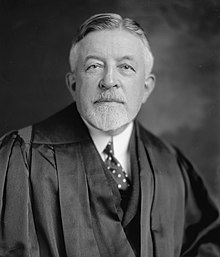
Back إدوارد تيري سانفورد Arabic ادوارد تيرى سانفورد ARZ Edward Terry Sanford German אדוארד סנפורד HE Edward Terry Sanford ID Edward Terry Sanford Portuguese
Edward Terry Sanford | |
|---|---|
 | |
| Associate Justice of the Supreme Court of the United States | |
| In office February 19, 1923 – March 8, 1930 | |
| Nominated by | Warren G. Harding |
| Preceded by | Mahlon Pitney |
| Succeeded by | Owen Roberts |
| Judge of the United States District Court for the Eastern District of Tennessee | |
| In office May 18, 1908 – February 5, 1923 | |
| Nominated by | Theodore Roosevelt |
| Preceded by | Charles Dickens Clark |
| Succeeded by | Xenophon Hicks |
| United States Assistant Attorney General | |
| In office 1907–1908 | |
| President | Theodore Roosevelt |
| Preceded by | William H. Lewis |
| Succeeded by | James Alexander Fowler |
| Personal details | |
| Born | Edward Terry Sanford July 23, 1865 Knoxville, Tennessee, U.S. |
| Died | March 8, 1930 (aged 64) Washington, D.C., U.S. |
| Resting place | Greenwood Cemetery Knoxville, Tennessee |
| Political party | Republican |
| Spouse |
Lutie Woodruff (m. 1891) |
| Parent |
|
| Relatives | Albert Chavannes |
| Education | University of Tennessee (BA, BPhil) Harvard University (AB, AM, LLB) |
| Signature | |
Edward Terry Sanford (July 23, 1865 – March 8, 1930) was an American jurist who served as an associate justice of the Supreme Court of the United States from 1923 until his death in 1930. Prior to his nomination to the high court, Sanford served as a United States Assistant Attorney General under President Theodore Roosevelt from 1905 to 1907, and as a United States district judge of the United States District Court for the Eastern District of Tennessee and the United States District Court for the Middle District of Tennessee from 1908 to 1923. As of 2023, he is the last sitting district court judge to be elevated directly to the Supreme Court.
A graduate of Harvard Law School, Sanford practiced law in his hometown of Knoxville, Tennessee, during the 1890s and the first decade of the 20th century.[1] As Assistant Attorney General, he rose to national prominence as lead prosecutor during the high-profile trial of Joseph Shipp in 1907, which to date is the only criminal trial conducted by the Supreme Court.[2][3]
Sanford is typically viewed as a conservative justice, favoring strict adherence to antitrust laws, and often voted with his mentor, Chief Justice William Howard Taft.[1] Sanford's most lasting impact on American law is arguably his majority opinion in the landmark case Gitlow v. New York (1925). This case, which introduced the incorporation doctrine, helped pave the way for many of the Warren Court's decisions expanding civil rights and civil liberties in the 1950s and 1960s.[1]
- ^ a b c Cite error: The named reference
laska2was invoked but never defined (see the help page). - ^ Cite error: The named reference
shippwas invoked but never defined (see the help page). - ^ Curriden, Mark (June 1, 2009). "A Supreme Case of Contempt: A tragic legal saga paved the way for civil rights protections and federal habeas actions". ABA Journal. Archived from the original on June 12, 2009. Retrieved February 2, 2011.
© MMXXIII Rich X Search. We shall prevail. All rights reserved. Rich X Search